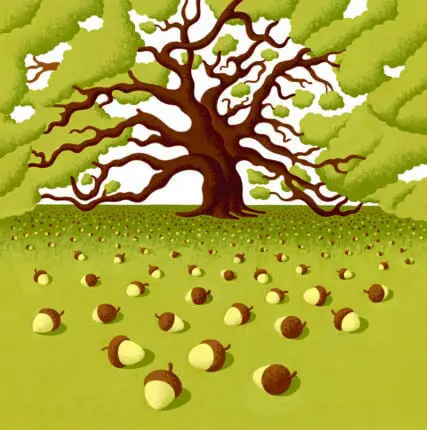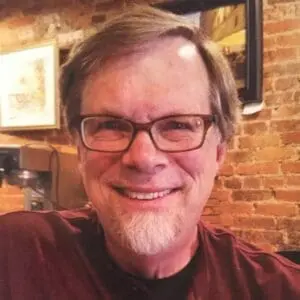Although it’s been 30 years, I can still hear my wife calling to me from the upstairs bathroom, her voice sounding frightened, yet struggling to remain calm. I ran up the stairs, telling our daughter, Rachel, 7 at the time, not to follow. My wife and I stood together, numbly staring into the toilet bowl, the water a brownish crimson. How could this be happening? Everything had been fine. No hint of any problem. And now, after nine weeks, this. When I returned to our daughter, I explained that “Mommy has a stomachache and is lying down.”
Fearing the worst, I leafed through one of our many pregnancy books, finding the chapter that, prior to this, I’d felt no need to read. With an almost breezy air, it said, “Miscarriage is very common. At least 1 pregnancy in 10 winds up in spontaneous abortion. If this proportion seems high to you, remember that nature is extravagant. She always starts out with more individuals, whether of flesh, fish, or flowers, than can have any real expectation of survival to maturity.”
I’d never thought about nature’s extravagance, its fecundity, its limitless fertility. Not just an egg at a time, but explosions of life, so remarkable that they can take one’s breath away. In Pilgrim at Tinker Creek, Annie Dillard writes that the ordinary rock barnacle covering a half mile of rocky shoreline can release “a million million” larvae into the sea. Or even more startlingly, a single aphid reproducing on its own for one year can produce enough aphids to be stacked 25 light-years out into space. Dillard marvels at this “careless bounty.” And so do I—perhaps even more so because nature’s propensity for producing life is matched only by its propensity for producing death: “If an aphid lays a million eggs, several might survive,” writes Dillard.
So what chance do a single egg and a single sperm have?
The next day, we sat in the doctor’s office, anxious, looking around the waiting room at other expectant mothers, their faces relaxed. The doctor examined my wife and explained that the cervix, much like a purse, was still drawn tight, protecting its contents. Later that day, she had an ultrasound that indicated the fetus still had a heartbeat.
For a moment, we were caught up again in the exuberance of life’s beginnings. Maybe this was just part of the process—normal in a slightly abnormal way, something we’d talk about in future years, shaking our heads nostalgically. Or was this tiny heart the eye of a storm that was building quickly? We huddled together in the face of it.
When the symptoms continued, we decided to tell Rachel that something was happening that could end the pregnancy. She was silent. She asked if there was a shot that could make it better. Then she sat on her mother’s lap and cried.
A few days later, we went for another exam. This time, there was tissue in the birth canal. The fetus had “just stopped growing,” said the doctor. Why? We struggled with feelings of responsibility and guilt, wondering if we’d done something wrong, if we’d inadvertently put this pregnancy at risk. The doctor tried to reassure us, listing numerous factors that could have contributed to this outcome. In the end, she said there was no way to know. Unfortunately, not knowing only heightened our sense of failure.
The days of waiting for the D&C, the procedure that removes whatever tissue is left in the uterus, were torturous for my wife. It felt like there was no end in sight, like she’d always be carrying a remnant inside her, a tragic reminder of what might have been. Eager for any enjoyable distraction, we took our daughter for ice cream the night before my wife was admitted to the hospital. While I ordered, Rachel asked her mother question upon question.
“How do you make a baby?”
“The way we explained it to you.”
“Daddy has to put his penis . . .”
“Yes.”
“Well, why don’t you do it here in the car? I won’t look.”
The next day, Rachel went to the hospital with us. She wanted to take care of her mother. She arranged and rearranged everything on my wife’s nightstand until she was satisfied with the order she’d created. Rachel also asked her mother to lie down on the bed and then sit up so she’d know exactly where to put her mother’s slippers on the floor. When we said goodbye to my wife and then left the hospital, Rachel asked me not to talk about her mother for the rest of the evening; it made her too sad.
More bleeding and tears came in the week after the D&C, but they brought a feeling of relief, a feeling of having been emptied, even cleansed. During that week, I had a dream in which I was told I needed heart surgery. The surgery left only the tiniest of scars. I asked the surgeon about this. He explained that I hadn’t needed surgery after all. I only needed to have my heart cleaned out. Of course.
Only years later did I learn that 1 out of 2 fertilized eggs die spontaneously without the woman ever knowing she’d been pregnant. And among women who know they’re expecting, as many as 1 in 5 will miscarry by the seventh week. As with all of nature, a majority of fertilized eggs will be lost. No favoritism here.
Thus ended our second pregnancy. For reasons we’d never understand, the dance of sperm and egg did not take, and so they were summarily swept off life’s dance floor. Happily, wonderfully, there was a third pregnancy within the next year. Our second daughter was born safe and sound. Emily is her name.
As for Rachel, she grew into womanhood, married, and had her first daughter, Gianna, in 2009. Her second pregnancy came a little more than a year later. Again there was a frantic call, this time by phone. Our daughter’s voice was panicky, much as her mother’s had been so many years before. She told me she thought her water had broken, but instead there was blood. Could I come to watch Gianna so they could go immediately to the hospital? I called my wife at work as I drove through the snow to our daughter and son-in-law’s house. When I arrived, my son-in-law was standing in the driveway. We said little. I waved to our daughter and they were off.
When I entered the house and found blood in the bathroom, my insides went cold. My wife arrived shortly thereafter and together we began to clean, finding even more blood in the living room, so much that we scrubbed for what seemed like forever. Could this really be happening? I thought.
After a time, we decided that I should go to the hospital while my wife waited at the house, Gianna fast asleep. I sat on the floor outside surgery, waiting. It was a long, quiet time. Our son-in-law finally emerged with good news. Though she was a month early, Makayla had made her way safely into the world. When it was clear that mother and daughter were doing fine, he told me that the doctors said “we’d have lost them both” if they’d reached the hospital even 15 minutes later. After a while, I went back to our daughter’s house to watch over Gianna so my wife could visit our new granddaughter. She drove the same route to the hospital that our son-in-law had taken, but was stopped by a train along the way for more than 15 minutes.
So what chance do a single egg and a single sperm have? In most cases, almost none. Nature is prolific, cornucopian, excessive in its reproductive drive, and yet its success rate is embarrassingly modest. Death is actually the rule, while life is the exception, but we count on those exceptions, because each of them, each birth, reveals what’s exceptional, what’s miraculous. From the first cell division to the final journey down the birth canal, risks and dangers abound. And yet births happen. Life bursts on the scene like a divine proclamation. A baby’s first cry is like a holy protestation, defying nature’s odds and trumpeting hope. In all my life, nothing has been of greater consequence or meaning than these exceptional exceptions.
Illustration © Adam Niklewicz
David Seaburn
David Seaburn was an Assistant Professor of Psychiatry and Family Medicine at the University of Rochester Medical Center for nearly 20 years, where he was Director of the Family Therapy Training Program (Psychiatry) and Coordinator of the Psychosocial Medicine Rotation (Family Medicine). He’s the co-author of Family-oriented Primary Care: A Manual for Medical Providers (1990) and Models of Collaboration: A Guide for Mental Health Professionals Working with Health Care Practitioners (1996) and the author of nine novels, including Darkness is as Light (2005), Pumpkin Hill (2007), Charlie No Face (2011), Chimney Bluffs (2012), More More Time (2015), Parrot Talk (2017), Gavin Goode (2019), Broken Pieces of God (2021), and Give Me Shelter (2022). He was a founding member of the Collaborative Family Healthcare Association and its former Treasurer. In 2005, he left the Medical Center to become Director of the Family Support Center in the Spencerport Central School District, a free counseling center for students and their families.












